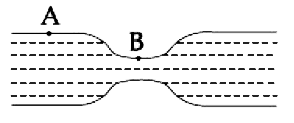We have two (narrow) capillary tubes T1 and T2 . Their lengths are l1 and l2 and radii of cross-section are r1 and r2 respectively. The rate of flow of water under a pressure difference P through tube T is 8cm3/sec. If l1=2l2 and r1=r2 what will be the rate of flow when the two tubes are connected in series and pressure difference across the combinatin is same as before (=P)
4cm3s−1
163cm3s−1
817cm3s−1
8cm3s−1
The correct Answer is:B
To solve the problem, we need to analyze the flow of water through two capillary tubes connected in series. We will use the principles of fluid dynamics, specifically Poiseuille's law, which describes the flow rate of a viscous fluid through a cylindrical pipe.
1. Understanding the Given Information:
- We have two capillary tubes, T1 and T2.
- The lengths are l1 and l2, and the radii are r1 and r2.
- It is given that l1=2l2 and r1=r2.
- The rate of flow through tube T1 is Q1=8cm3/sec.
2. Using Poiseuille's Law:
- The volume flow rate Q through a capillary tube is given by:
Q=Pπr48ηL
where P is the pressure difference, η is the viscosity of the fluid, r is the radius, and L is the length of the tube.
3. Finding the Resistance for Each Tube:
- The resistance R for a tube can be expressed as:
R=8ηLπr4
- For tube T1:
R1=8ηl1πr41
- For tube T2:
R2=8ηl2πr42
4. Substituting the Lengths:
- Since l1=2l2 and r1=r2, we can express R2 in terms of R1:
R2=8ηl2πr4=8ηl12πr4=R12
5. Calculating Total Resistance in Series:
- When the tubes are connected in series, the total resistance Rtotal is:
Rtotal=R1+R2=R1+R12=3R12
6. Finding the New Flow Rate:
- The new flow rate Qtotal through the combination of the two tubes can be calculated using the total resistance:
Qtotal=PRtotal=P3R12=2P3R1
- Since Q1=PR1=8cm3/sec, we can express P in terms of R1:
P=8R1
- Substituting this into the equation for Qtotal:
Qtotal=2(8R1)3R1=163cm3/sec
Conclusion:
The rate of flow when the two tubes are connected in series is 163cm3/sec.
- We have two capillary tubes, T1 and T2.
- The lengths are l1 and l2, and the radii are r1 and r2.
- It is given that l1=2l2 and r1=r2.
- The rate of flow through tube T1 is Q1=8cm3/sec.
- The volume flow rate Q through a capillary tube is given by:
Q=Pπr48ηL
where P is the pressure difference, η is the viscosity of the fluid, r is the radius, and L is the length of the tube.
- The resistance R for a tube can be expressed as:
R=8ηLπr4
- For tube T1:
R1=8ηl1πr41
- For tube T2:
R2=8ηl2πr42
- Since l1=2l2 and r1=r2, we can express R2 in terms of R1:
R2=8ηl2πr4=8ηl12πr4=R12
- When the tubes are connected in series, the total resistance Rtotal is:
Rtotal=R1+R2=R1+R12=3R12
- The new flow rate Qtotal through the combination of the two tubes can be calculated using the total resistance:
Qtotal=PRtotal=P3R12=2P3R1
- Since Q1=PR1=8cm3/sec, we can express P in terms of R1:
P=8R1
- Substituting this into the equation for Qtotal:
Qtotal=2(8R1)3R1=163cm3/sec
The rate of flow when the two tubes are connected in series is 163cm3/sec.
Similar Questions
Two capillary tubes of lengths in the ratio 2:1 and radii in the ratio 1:2 are connected in series. Assume the flow of the liquid through the tube is steady. Then, the ratio of pressure difference across the tubes is
View SolutionThe rate of flow of a liquid through a capillary tube of radius r is under a pressure difference of P. Calculate the rate of flow when the diameter is reduced to half and the pressure difference is made 4 P?
View Solution
Knowledge Check
Two copper wire of length l and 2l have radii, r and 2r respectively. What si the ratio of their specific resistance.?
A1:2B2:1C1:1D1:3Two soap bubbles A and B have radii r1andr2 respectively. If r1<r2 than the excess pressure inside
Abubbles A and B will be equalBbubbles A will be less than that in bubbles BCbubbles A will be greater than that in bubble BDbubbles A and B will be zero.
Two wires of different materials of resistivity p1andp2 , length l1andl2, and area of cross-section A1andA2 respectively are connected in parallel. The ratio of current density in the two wires,j1j2 , is given by:
View SolutionWater flows in a horizontal tube as shown in figure. The pressure of water changes by 600 N m^-2 between A and B where the areas of cross section are 30cm^2 and 15cm^2 respectively. Find the rate of flow of water through the tube.
 ,
,
View SolutionThe rate of steady volume flow of water through a capillary tube of length ' l ' and radius ' r ' under a pressure difference of P is V . This tube is connected with another tube of the same length but half the radius in series. Then the rate of steady volume flow through them is (The pressure difference across the combination is P )
View SolutionThe water flowing through the same tube having two different cross section areas has different flow rates .
View SolutionWater flows in a horizontal tube (see figure). The pressure of water changes by 700 Nm−2 between A and B where the area of cross section are 40cm2 and 20cm2, respectively. Find the rate of flow of water through the tube.

View SolutionA liquid flows through two capillary tube under the same pressure head. The lengths of the tube are in the ratio 2:1 and the ratio of their diameters is 2:3. Compare the rates of flow of liquid through the tubes ?
View Solution
